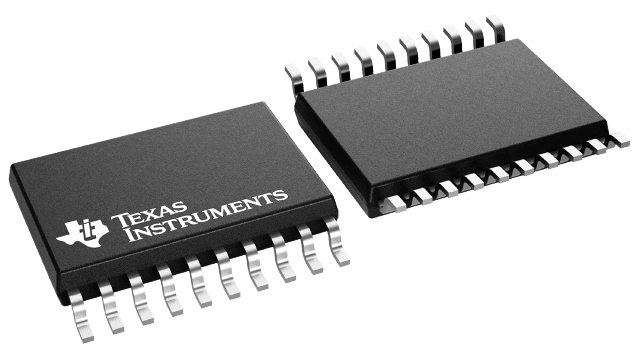Información de empaque
| Encapsulado | Pines TSSOP (PW) | 20 |
| Rango de temperatura de funcionamiento (℃) -40 to 85 |
| Cant. de paquetes | Empresa de transporte 70 | TUBE |
Características para MSP430FR2311
- Embedded microcontroller
- 16-bit RISC architecture up to 16 MHz
- Wide supply voltage range from 3.6 V down to 1.8 V (minimum supply voltage is restricted by SVS levels, see the SVS Specifications)
- Optimized low-power modes (at 3 V)
- Active mode: 126 µA/MHz
- Standby: real-time clock (RTC) counter (LPM3.5 with 32768-Hz crystal): 0.71 µA
- Shutdown (LPM4.5): 32 nA without SVS
- High-performance analog
- Transimpedance amplifier (TIA)
(1)
- Current-to-voltage conversion
- Half-rail input
- Low-leakage negative input down to 5 pA, enabled on TSSOP16 package only
- Rail-to-rail output
- Multiple input selections
- Configurable high-power and low-power modes
- 8-channel 10-bit analog-to-digital converter
(ADC)
- Internal 1.5-V reference
- Sample-and-hold 200 ksps
- Enhanced comparator (eCOMP)
- Integrated 6-bit digital-to-analog converter (DAC) as reference voltage
- Programmable hysteresis
- Configurable high-power and low-power modes
- Smart analog combo (SAC-L1)
- Supports general-purpose op amp
- Rail-to-rail input and output
- Multiple input selections
- Configurable high-power and low-power modes
- Transimpedance amplifier (TIA)
(1)
- Low-power ferroelectric RAM (FRAM)
- Up to 3.75KB of nonvolatile memory
- Built-in error correction code (ECC)
- Configurable write protection
- Unified memory of program, constants, and storage
- 1015 write cycle endurance
- Radiation resistant and nonmagnetic
- Intelligent digital peripherals
- IR modulation logic
- Two 16-bit timers with three capture/compare registers each (Timer_B3)
- One 16-bit counter-only RTC counter
- 16-bit cyclic redundancy checker (CRC)
- Enhanced serial communications
- Enhanced USCI A (eUSCI_A) supports UART, IrDA, and SPI
- Enhanced USCI B (eUSCI_B) supports SPI and I2C with support for remap feature (see Signal Descriptions)
- Clock system (CS)
- On-chip 32-kHz RC oscillator (REFO)
- On-chip 16-MHz digitally controlled oscillator (DCO) with frequency locked
loop (FLL)
- ±1% accuracy with on-chip reference at room temperature
- On-chip very low-frequency 10-kHz oscillator (VLO)
- On-chip high-frequency modulation oscillator (MODOSC)
- External 32-kHz crystal oscillator (LFXT)
- External high-frequency crystal oscillator up to 16 MHz (HFXT)
- Programmable MCLK prescalar of 1 to 128
- SMCLK derived from MCLK with programmable prescalar of 1, 2, 4, or 8
- General input/output and pin functionality
- 16 I/Os on 20-pin package
- 12 interrupt pins (8 pins of P1 and 4 pins of P2) can wake MCU from LPMs
- All I/Os are capacitive touch I/Os
- Development tools and software
- LaunchPad™ development kit (MSP‑EXP430FR2311)
- Target development board (MSP‑TS430PW20)
- Family members (also see Device Comparison)
- MSP430FR2311: 3.75KB of program FRAM and 1KB of RAM
- MSP430FR2310: 2KB of program FRAM and 1KB of RAM
- Package options
- 20-pin TSSOP (PW20)
- 16-pin TSSOP (PW16)
- 16-pin VQFN (RGY16)
(1)The transimpedance amplifier was originally given an abbreviation of TRI in descriptive text, pin names, and register names. The abbreviation has changed to TIA in all descriptive text, but pin names and register names still use TRI.
Descripción de MSP430FR2311
The MSP430FR231x FRAM microcontrollers (MCUs) are part of the MSP430™ MCU value line sensing family. The devices integrate a configurable low-leakage transimpedance amplifier (TIA) and a general purpose operational amplifier. The MCUs feature a powerful 16-bit RISC CPU, 16-bit registers, and a constant generator that contribute to maximum code efficiency. The digitally controlled oscillator (DCO) also allows the device to wake up from low-power modes to active mode typically in less than 10 µs. The feature set of these MCUs are well suited for applications ranging from smoke detectors to portable health and fitness accessories.
The ultra-low-power MSP430FR231x MCU family consists of several devices that feature embedded nonvolatile FRAM and different sets of peripherals targeted for various sensing and measurement applications. The architecture, FRAM, and peripherals, combined with extensive low-power modes, are optimized to achieve extended battery life in portable and wireless sensing applications. FRAM is a nonvolatile memory technology that combines the speed, flexibility, and endurance of SRAM with the stability and reliability of flash at lower total power consumption.
The MSP430FR231x MCUs are supported by an extensive hardware and software ecosystem with reference designs and code examples to get your design started quickly. Development kits include the MSP‑EXP430FR2311 LaunchPad™ development kit and the MSP‑TS430PW20 20-pin target development board. TI provides free MSP430Ware™ software, which is available as a component of Code Composer Studio™ IDE desktop and cloud versions within TI Resource Explorer. The MSP430 MCUs are also supported by extensive online collateral, training, and online support through the E2E™ Community Forum.
For complete module descriptions, see the MSP430FR4xx and MSP430FR2xx Family User’s Guide.
